brake fluid SSANGYONG NEW ACTYON SPORTS 2012 Service Manual
[x] Cancel search | Manufacturer: SSANGYONG, Model Year: 2012, Model line: NEW ACTYON SPORTS, Model: SSANGYONG NEW ACTYON SPORTS 2012Pages: 828, PDF Size: 91.28 MB
Page 127 of 828
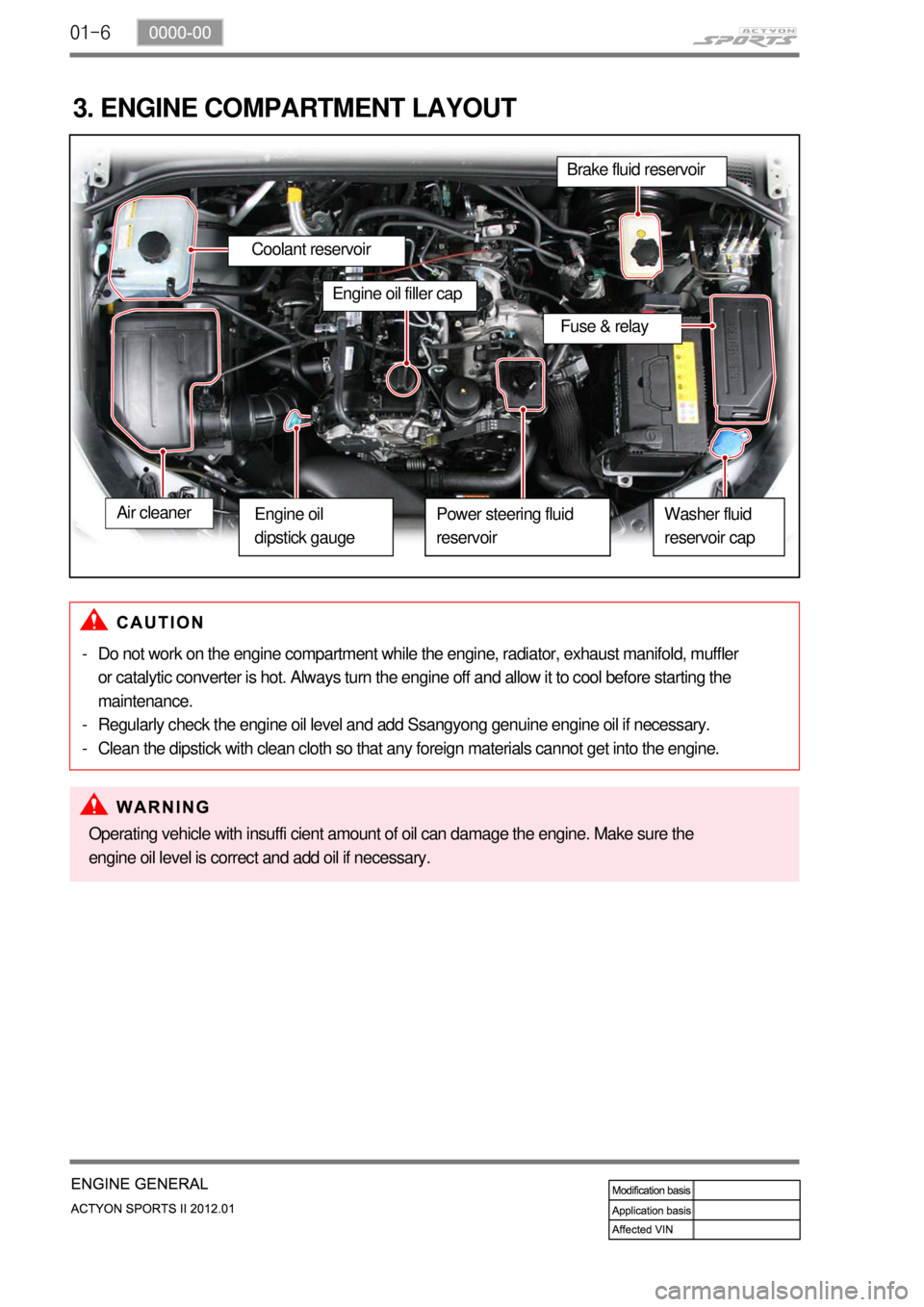
01-6
3. ENGINE COMPARTMENT LAYOUT
Do not work on the engine compartment while the engine, radiator, exhaust manifold, muffler
or catalytic converter is hot. Always turn the engine off and allow it to cool before starting the
maintenance.
Regularly check the engine oil level and add Ssangyong genuine engine oil if necessary.
Clean the dipstick with clean cloth so that any foreign materials cannot get into the engine. -
-
-
Power steering fluid
reservoirBrake fluid reservoir
Fuse & relay
Engine oil
dipstick gaugeWasher fluid
reservoir cap Engine oil filler cap
Air cleaner
Operating vehicle with insuffi cient amount of oil can damage the engine. Make sure the
engine oil level is correct and add oil if necessary.
Coolant reservoir
Page 511 of 828
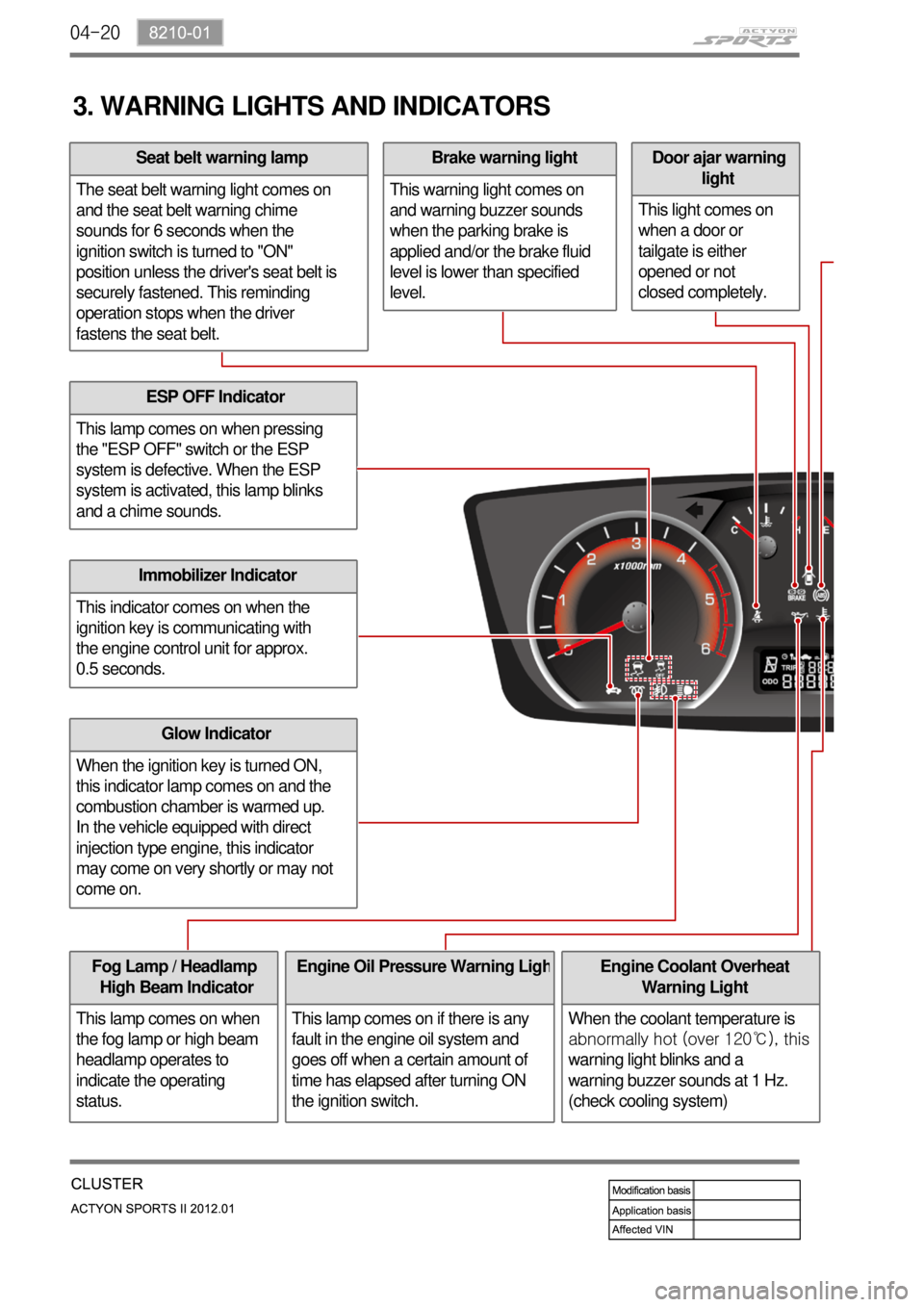
04-20
3. WARNING LIGHTS AND INDICATORS
ESP OFF Indicator
This lamp comes on when pressing
the "ESP OFF" switch or the ESP
system is defective. When the ESP
system is activated, this lamp blinks
and a chime sounds.
Immobilizer Indicator
This indicator comes on when the
ignition key is communicating with
the engine control unit for approx.
0.5 seconds.
Glow Indicator
When the ignition key is turned ON,
this indicator lamp comes on and the
combustion chamber is warmed up.
In the vehicle equipped with direct
injection type engine, this indicator
may come on very shortly or may not
come on.
Fog Lamp / Headlamp
High Beam Indicator
This lamp comes on when
the fog lamp or high beam
headlamp operates to
indicate the operating
status.Engine Oil Pressure Warning Ligh
This lamp comes on if there is any
fault in the engine oil system and
goes off when a certain amount of
time has elapsed after turning ON
the ignition switch.
Door ajar warning
light
This light comes on
when a door or
tailgate is either
opened or not
closed completely.Brake warning light
This warning light comes on
and warning buzzer sounds
when the parking brake is
applied and/or the brake fluid
level is lower than specified
level.Seat belt warning lamp
The seat belt warning light comes on
and the seat belt warning chime
sounds for 6 seconds when the
ignition switch is turned to "ON"
position unless the driver's seat belt is
securely fastened. This reminding
operation stops when the driver
fastens the seat belt.
Engine Coolant Overheat
Warning Light
When the coolant temperature is
abnormally hot (over 120℃), this
warning light blinks and a
warning buzzer sounds at 1 Hz.
(check cooling system)
Page 555 of 828
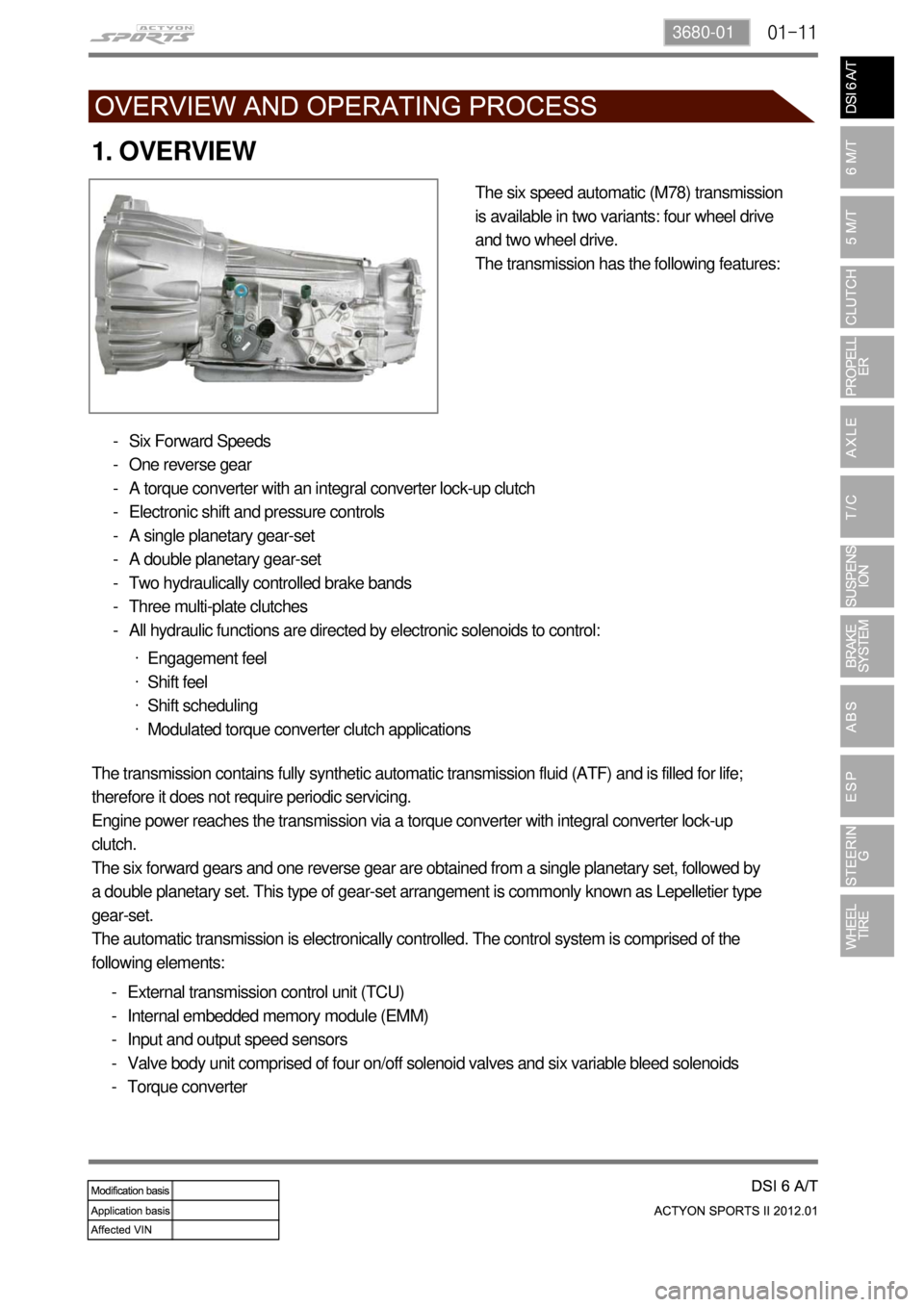
01-113680-01
1. OVERVIEW
The six speed automatic (M78) transmission
is available in two variants: four wheel drive
and two wheel drive.
The transmission has the following features:
Six Forward Speeds
One reverse gear
A torque converter with an integral converter lock-up clutch
Electronic shift and pressure controls
A single planetary gear-set
A double planetary gear-set
Two hydraulically controlled brake bands
Three multi-plate clutches
All hydraulic functions are directed by electronic solenoids to control: -
-
-
-
-
-
-
-
-
Engagement feel
Shift feel
Shift scheduling
Modulated torque converter clutch applications ·
·
·
·
The transmission contains fully synthetic automatic transmission fluid (ATF) and is filled for life;
therefore it does not require periodic servicing.
Engine power reaches the transmission via a torque converter with integral converter lock-up
clutch.
The six forward gears and one reverse gear are obtained from a single planetary set, followed by
a double planetary set. This type of gear-set arrangement is commonly known as Lepelletier type
gear-set.
The automatic transmission is electronically controlled. The control system is comprised of the
following elements:
External transmission control unit (TCU)
Internal embedded memory module (EMM)
Input and output speed sensors
Valve body unit comprised of four on/off solenoid valves and six variable bleed solenoids
Torque converter -
-
-
-
-
Page 651 of 828
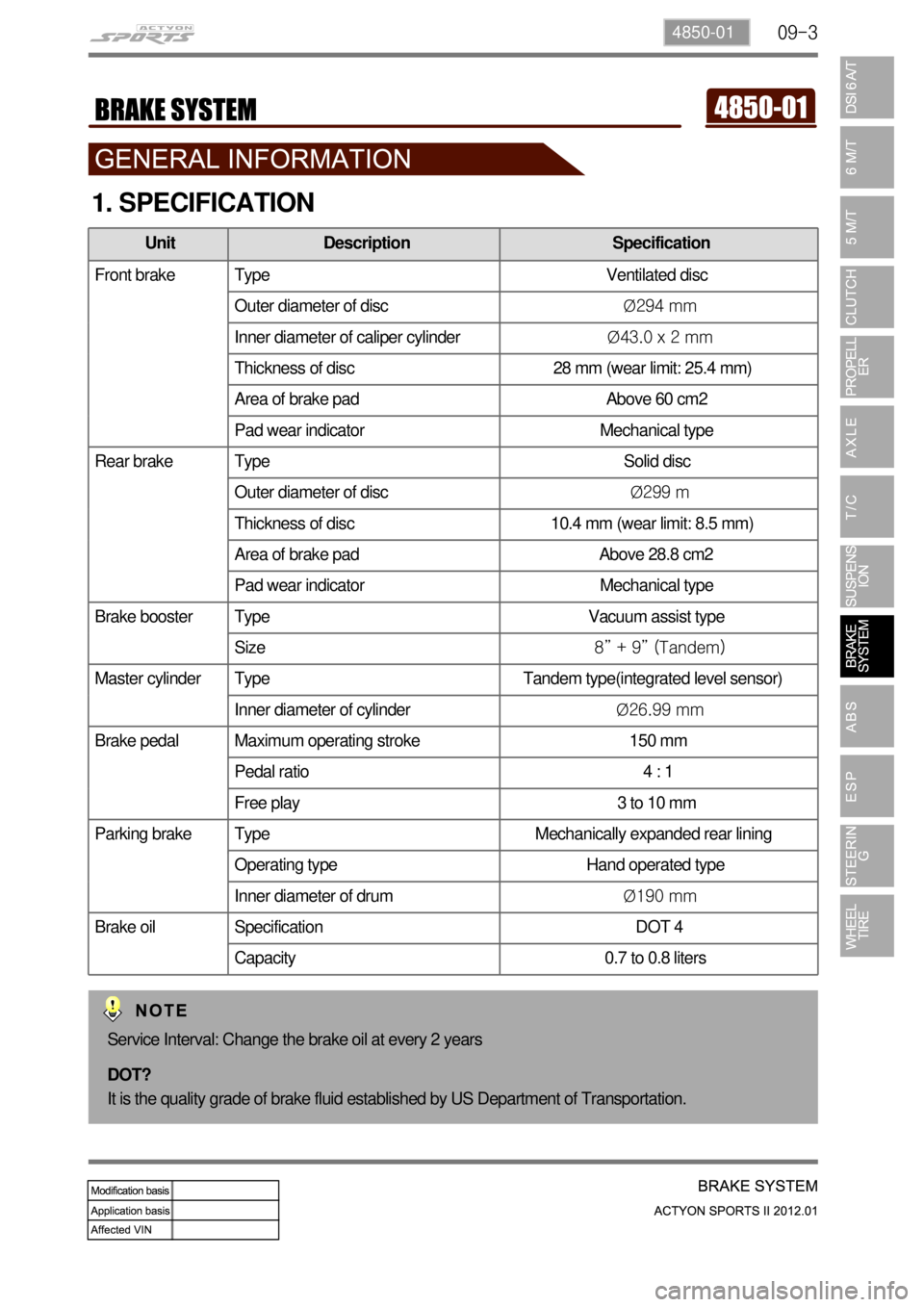
09-34850-01
1. SPECIFICATION
Unit Description Specification
Front brake Type Ventilated disc
Outer diameter of discØ294 mm
Inner diameter of caliper cylinderØ43.0 x 2 mm
Thickness of disc 28 mm (wear limit: 25.4 mm)
Area of brake pad Above 60 cm2
Pad wear indicator Mechanical type
Rear brake Type Solid disc
Outer diameter of discØ299 m
Thickness of disc 10.4 mm (wear limit: 8.5 mm)
Area of brake pad Above 28.8 cm2
Pad wear indicator Mechanical type
Brake booster Type Vacuum assist type
Size8” + 9” (Tandem)
Master cylinder Type Tandem type(integrated level sensor)
Inner diameter of cylinderØ26.99 mm
Brake pedal Maximum operating stroke 150 mm
Pedal ratio 4 : 1
Free play 3 to 10 mm
Parking brake Type Mechanically expanded rear lining
Operating type Hand operated type
Inner diameter of drumØ190 mm
Brake oil Specification DOT 4
Capacity 0.7 to 0.8 liters
Service Interval: Change the brake oil at every 2 years
DOT?
It is the quality grade of brake fluid established by US Department of Transportation.
Page 652 of 828
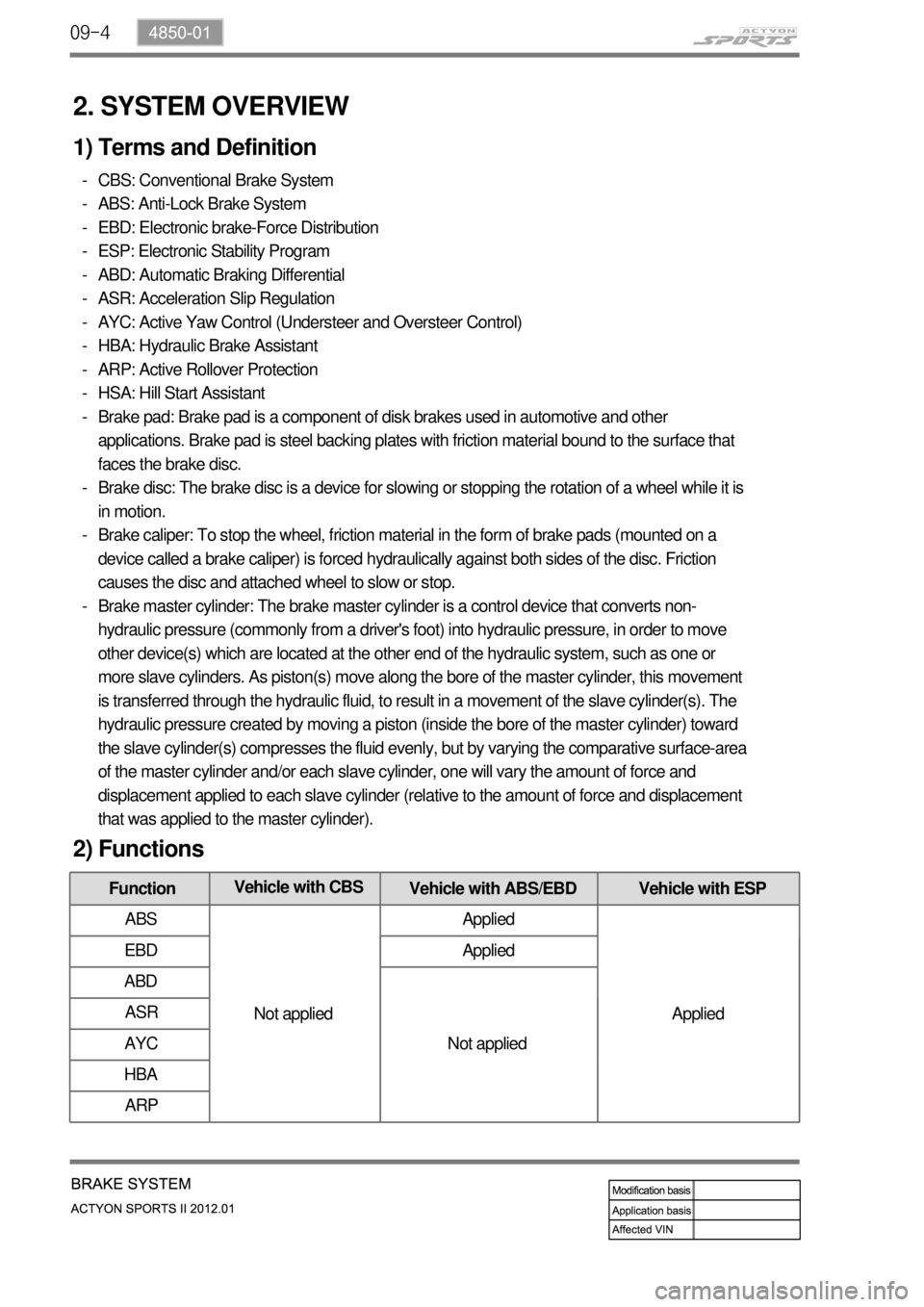
09-4
2. SYSTEM OVERVIEW
1) Terms and Definition
CBS: Conventional Brake System
ABS: Anti-Lock Brake System
EBD: Electronic brake-Force Distribution
ESP: Electronic Stability Program
ABD: Automatic Braking Differential
ASR: Acceleration Slip Regulation
AYC: Active Yaw Control (Understeer and Oversteer Control)
HBA: Hydraulic Brake Assistant
ARP: Active Rollover Protection
HSA: Hill Start Assistant
Brake pad: Brake pad is a component of disk brakes used in automotive and other
applications. Brake pad is steel backing plates with friction material bound to the surface that
faces the brake disc.
Brake disc: The brake disc is a device for slowing or stopping the rotation of a wheel while it is
in motion.
Brake caliper: To stop the wheel, friction material in the form of brake pads (mounted on a
device called a brake caliper) is forced hydraulically against both sides of the disc. Friction
causes the disc and attached wheel to slow or stop.
Brake master cylinder: The brake master cylinder is a control device that converts non-
hydraulic pressure (commonly from a driver's foot) into hydraulic pressure, in order to move
other device(s) which are located at the other end of the hydraulic system, such as one or
more slave cylinders. As piston(s) move along the bore of the master cylinder, this movement
is transferred through the hydraulic fluid, to result in a movement of the slave cylinder(s). The
hydraulic pressure created by moving a piston (inside the bore of the master cylinder) toward
the slave cylinder(s) compresses the fluid evenly, but by varying the comparative surface-area
of the master cylinder and/or each slave cylinder, one will vary the amount of force and
displacement applied to each slave cylinder (relative to the amount of force and displacement
that was applied to the master cylinder). -
-
-
-
-
-
-
-
-
-
-
-
-
-
FunctionVehicle with CBS
Vehicle with ABS/EBD Vehicle with ESP
ABS
Not appliedApplied
Applied EBD Applied
ABD
Not applied ASR
AYC
HBA
ARP
2) Functions
Page 659 of 828
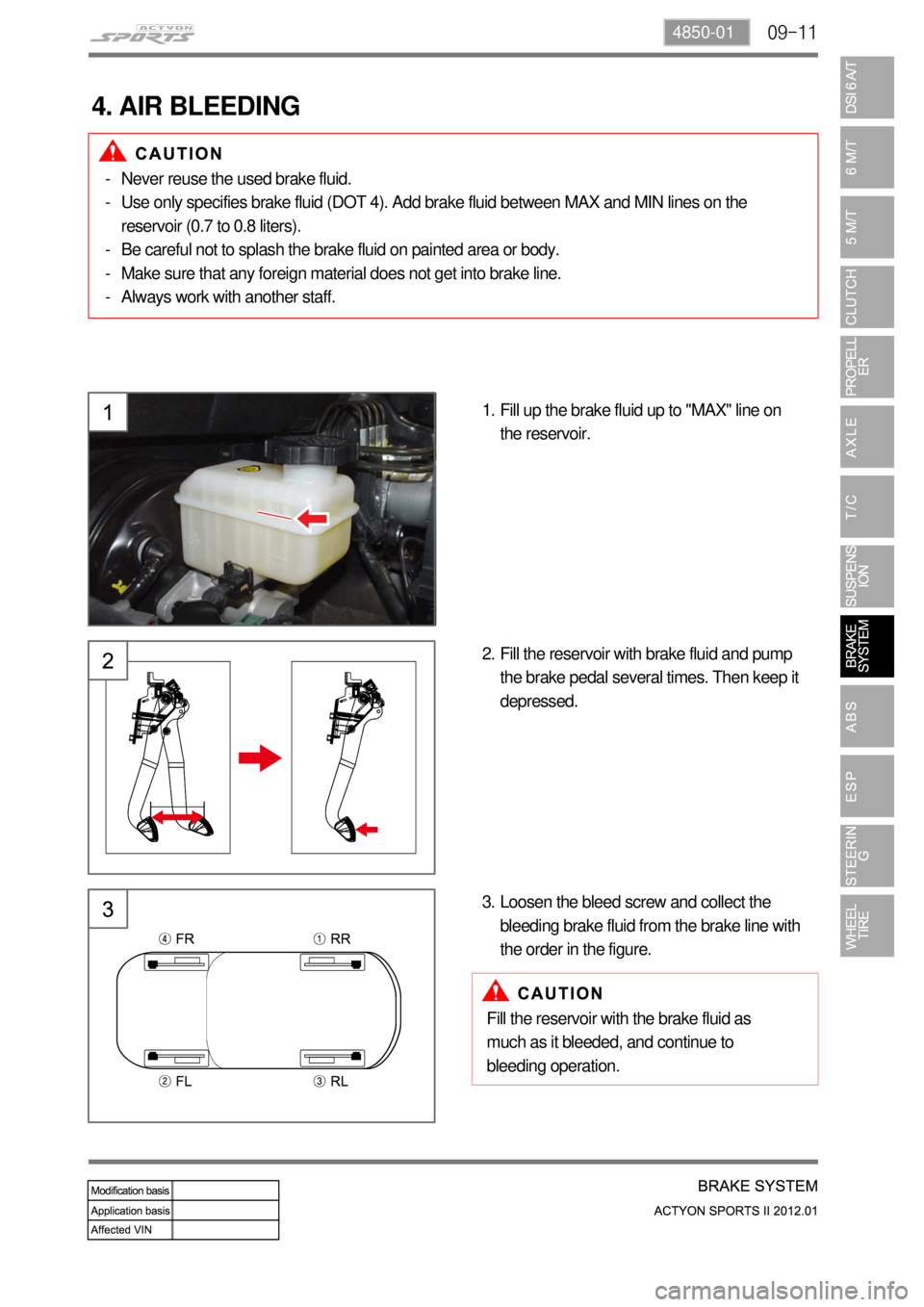
09-114850-01
4. AIR BLEEDING
Fill up the brake fluid up to "MAX" line on
the reservoir. 1.
Fill the reservoir with brake fluid and pump
the brake pedal several times. Then keep it
depressed. 2.
Loosen the bleed screw and collect the
bleeding brake fluid from the brake line with
the order in the figure. 3.
Fill the reservoir with the brake fluid as
much as it bleeded, and continue to
bleeding operation. Never reuse the used brake fluid.
Use only specifies brake fluid (DOT 4). Add brake fluid between MAX and MIN lines on the
reservoir (0.7 to 0.8 liters).
Be careful not to splash the brake fluid on painted area or body.
Make sure that any foreign material does not get into brake line.
Always work with another staff. -
-
-
-
-
Page 660 of 828
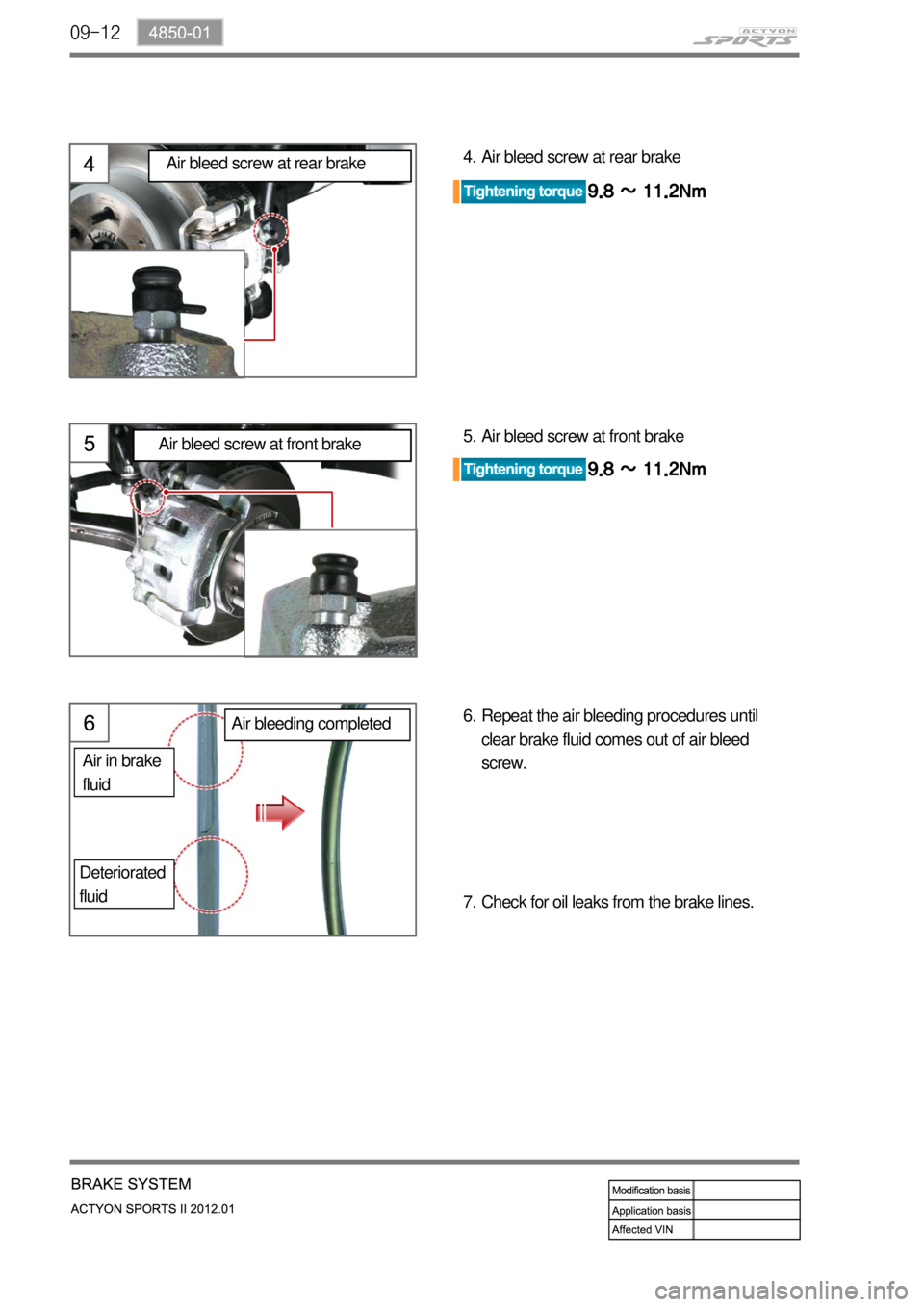
09-12
Air bleed screw at front brake 5.Air bleed screw at rear brake 4.
Repeat the air bleeding procedures until
clear brake fluid comes out of air bleed
screw. 6.
Check for oil leaks from the brake lines. 7.
Air in brake
fluid
Deteriorated
fluid
Air bleed screw at front brake
Air bleed screw at rear brake
Air bleeding completed
Page 661 of 828
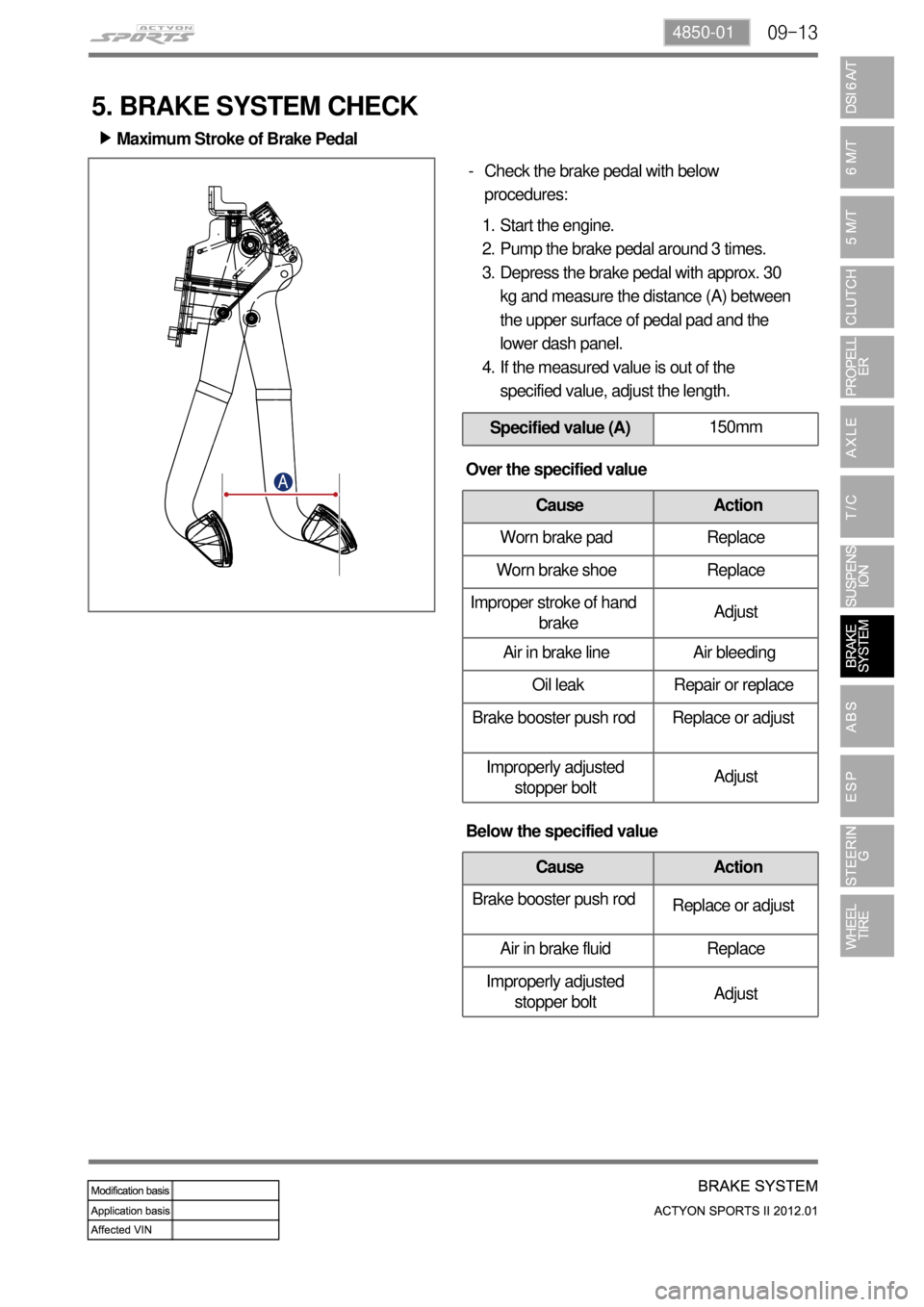
09-134850-01
Maximum Stroke of Brake Pedal ▶
Check the brake pedal with below
procedures: -
Start the engine.
Pump the brake pedal around 3 times.
Depress the brake pedal with approx. 30
kg and measure the distance (A) between
the upper surface of pedal pad and the
lower dash panel.
If the measured value is out of the
specified value, adjust the length. 1.
2.
3.
4.
Specified value (A)150mm
5. BRAKE SYSTEM CHECK
Over the specified value
Cause Action
Worn brake pad Replace
Worn brake shoe Replace
Improper stroke of hand
brakeAdjust
Air in brake line Air bleeding
Oil leak Repair or replace
Brake booster push rod Replace or adjust
Improperly adjusted
stopper boltAdjust
Below the specified value
Cause Action
Brake booster push rod
Replace or adjust
Air in brake fluid Replace
Improperly adjusted
stopper boltAdjust
Page 665 of 828
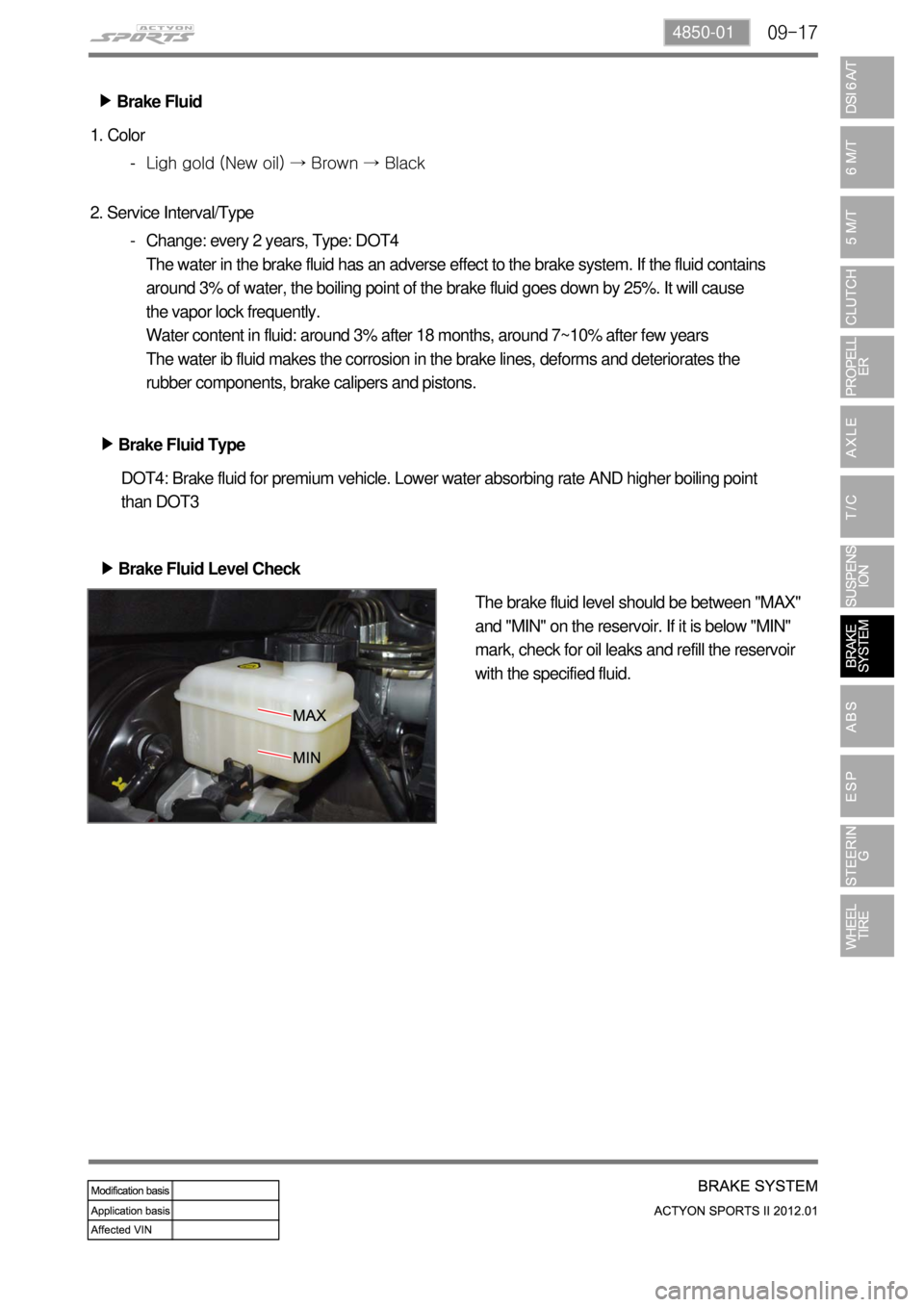
09-174850-01
Brake Fluid ▶
Brake Fluid Type ▶ 1. Color
Ligh gold (New oil) → Brown → Black -
2. Service Interval/Type
Change: every 2 years, Type: DOT4
The water in the brake fluid has an adverse effect to the brake system. If the fluid contains
around 3% of water, the boiling point of the brake fluid goes down by 25%. It will cause
the vapor lock frequently.
Water content in fluid: around 3% after 18 months, around 7~10% after few years
The water ib fluid makes the corrosion in the brake lines, deforms and deteriorates the
rubber components, brake calipers and pistons. -
DOT4: Brake fluid for premium vehicle. Lower water absorbing rate AND higher boiling point
than DOT3
Brake Fluid Level Check ▶
The brake fluid level should be between "MAX"
and "MIN" on the reservoir. If it is below "MIN"
mark, check for oil leaks and refill the reservoir
with the specified fluid.
Page 680 of 828
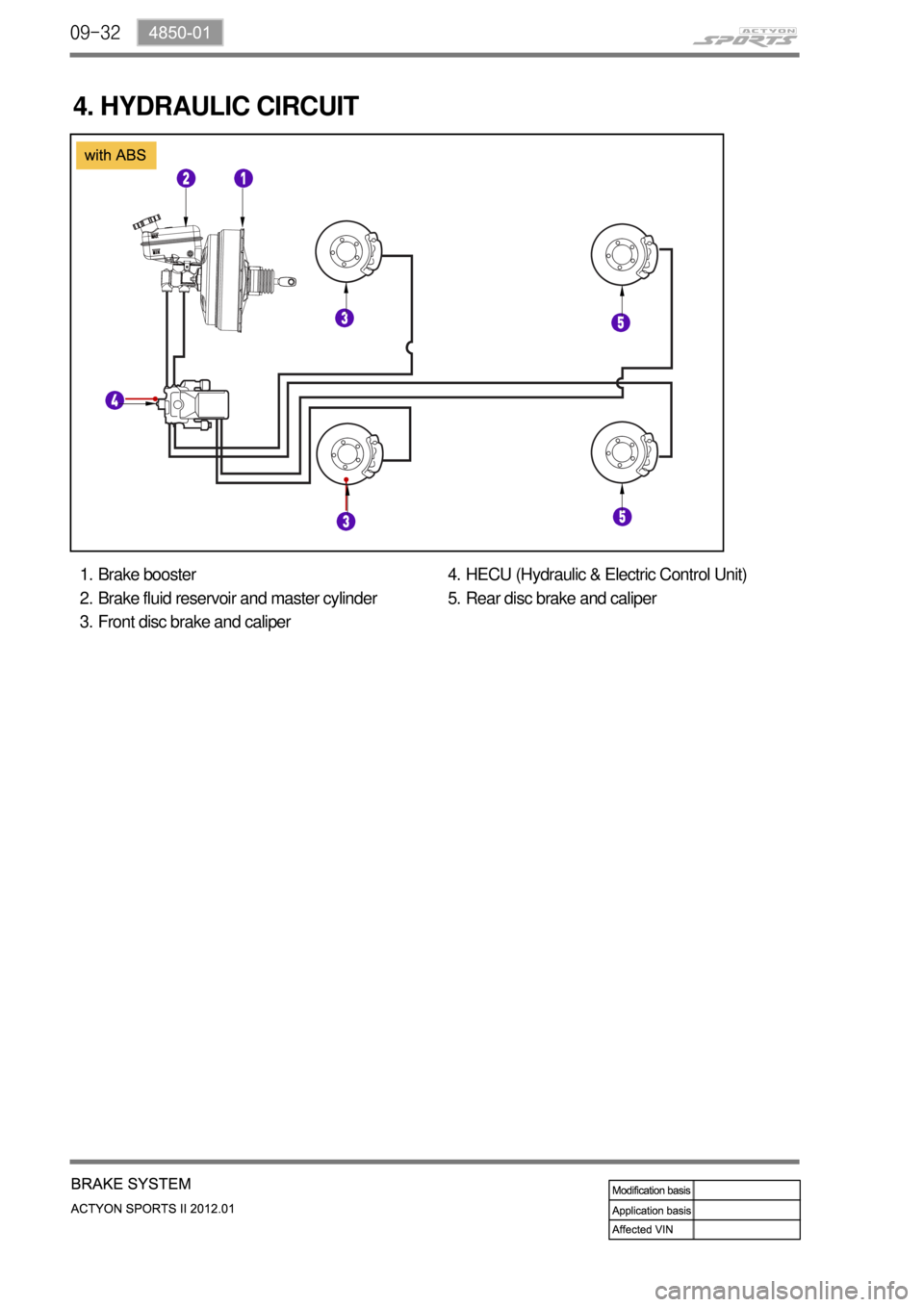
09-32
4. HYDRAULIC CIRCUIT
Brake booster
Brake fluid reservoir and master cylinder
Front disc brake and caliper 1.
2.
3.HECU (Hydraulic & Electric Control Unit)
Rear disc brake and caliper 4.
5.